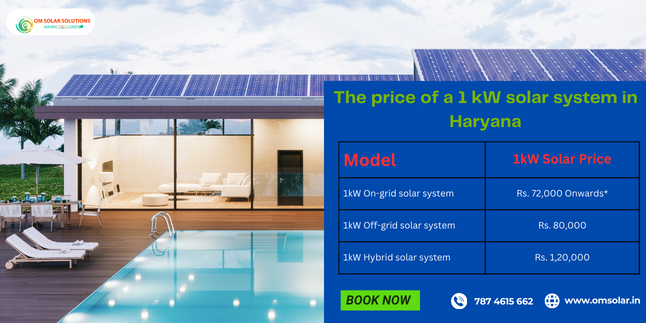Start small with a 1kW solar panel system to see what solar can do for your house or business. Although you should install as many solar panels as you can afford and your property will support, 1kW solar panels are best for small homes and businesses on a budget who want to reduce electrical stress and energy bills.
Summer power outages are common in India. The only way to get electricity during power outages is inverter batteries. Several Indian inverter battery manufacturers offer reliable products and residential services. Loom Solar, a rooftop solar company in India, offers complete solutions for homes and businesses, including rural locations.
Sunlight powers the 1 kW solar system to generate 4-5 units each day. In India with severe power disruptions, a 1 kW solar system can power 3-4 BHK homes for 8-10 hours. Monocrystalline panels provide above 97% inverter efficiency and 21% module efficiency. In this blog, we will know the 1kw solar panel price in Haryana with Subsidy and India.
Also Read: The Cost of a 5 kW Solar System in Haryana with Subsidy
Understanding the 1kW Solar Panel: An Introduction
A 1kW solar panel refers to a solar panel with a power output of 1 kilowatt. It is a device that converts sunlight into electricity and can generate 1 kilowatt of power. The dimensions of a 1 kW solar installation are contingent upon the type and quantity of panels used.
What is the number of solar panels needed to generate 1 kilowatt of power? Usually, it consists of approximately 4-6 solar panels. This configuration enables a highly efficient and space-saving system for converting solar energy into electrical power, making it ideal for home and small-scale uses.
Categories of 1kW Solar Panels
There are three primary categories of 1 kW solar panels that are frequently utilized in solar panel systems:
1. Solar panels made from a single crystal structure
Monocrystalline solar panels, commonly selected for 1 kW solar systems, are characterized by their exceptional efficiency and compact form.
These panels utilize single-crystal silicon to provide greater uniformity and efficiency in converting energy. Monocrystalline panels are highly efficient and therefore a good choice for rooftop installations.
Although they may have a higher price compared to alternative solutions, their superior energy efficiency and compact design make them a preferred choice for maximizing solar power generation in limited spaces.
2. Panels made of polycrystalline solar cells.
Polycrystalline solar panels consist of several solar cells operating collectively. Polycrystalline solar panels have a lower price point compared to monocrystalline panels, but they have a lower level of efficiency. Conceive them as an enormous silicon puzzle.
These panels are beneficial for reducing solar expenses. While they may not generate as much electricity per unit of space, they are a reliable option if you have a larger area at your disposal and are seeking a compromise between cost and efficiency.
If you delve into the details, you might also find it intriguing to explore a thorough analysis of Monocrystalline Vs. Polycrystalline Solar Panels – focusing on their efficiency, applications, and other relevant factors. This would additionally assist you in making a well-informed conclusion.
3. Photovoltaic panels made of thin films
Thin-film solar panels utilize a unique method that involves the application of thin layers of semiconductors onto different substrates. These panels have a significantly lower efficiency compared to crystalline panels, although they possess distinct advantages.
These solar panels are very lightweight, and flexible, and may be easily incorporated into different buildings, making them well-suited for specific uses such as building-integrated photovoltaics (BIPV).
Thin-film panels are well-suited for enhancing visual appeal, accommodating various installation locations, and adapting to irregular surfaces, despite their lower energy conversion efficiency compared to crystalline panels.
The price of a 1 kW solar system in Haryana
The current 1kw solar panel price in Haryana and India is contingent upon several aspects, including the type of solar panels, the quality of all the solar components, and the design of the mounting structure. Below is a projected cost analysis for a 1 kilowatt (kW) solar energy installation.

| Model | 1kW Solar Price |
| 1kW On-grid solar system | Rs. 72,000 Onwards* |
| 1kW Off-grid solar system | Rs. 80,000 |
| 1kW Hybrid solar system | Rs. 1,20,000 |
Note: The above prices are estimates and don’t include subsidy adjustments and other factors that might influence the final solar system prices for your home or business.
1kW Solar System Price in Haryana with Subsidy.
The subsidy on solar panels in the Haryana program offers financial assistance exclusively for home solar systems that are connected to the power grid and operate under the net metering framework.Â
| Model | 1kW Solar System Price | Subsidy Applicable | Prices After Subsidy |
| 1kW On-grid solar system | Rs. 72,000 Onwards* | Rs. 14,588 | Rs. 56,512 Onwards* |
| 1kW Off-grid solar system | Rs. 80,000 | Not applicable | – |
| 1kW Hybrid Solar System | Rs. 1,20,000 | Rs. 14,588 | Rs. 1,05,412 |
Most 1kw solar system prices in Haryana in India cost between Rs. 65,000 to Rs. 1,05,000. Prices vary by solar system type: on-grid, off-grid, and hybrid. Consumers can choose a single or double battery for a 1kW off-grid solar installation.
The 1kW off-grid solar system costs Rs. 75,000 with one battery. However, a twin battery setup costs Rs. 105,000. The solar system cost includes site study, products, delivery, installation, commissioning, service, and warranty.
Get Start NowOm Solar Solutions’ cheap on-grid solar system lets you switch to clean energy without breaking the bank. Our financial choices, user-friendly software, and state-competitive prices make solar electricity affordable for households like never before. Our Solar Installers in Haryana promote sustainability, lower electricity prices, and green the future.

